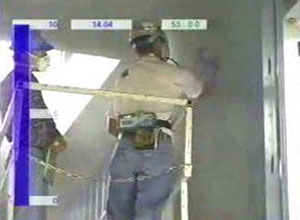Engineering Controls for Silica in Construction – Concrete Grinder

Engineering Controls for Silica in Construction
Concrete Grinder

Construction workers who perform concrete grinding may breathe dust that contains respirable crystalline silica (RCS). A NIOSH [1] study found that workers grinding concrete to smooth poured concrete surfaces were exposed to high levels of dust containing RCS, ranging from 35 to 55 times the NIOSH recommended exposure limit (REL). The Concrete Grinder without Engineering Controls video shows a worker performing a task with a concrete grinder while the overlay shows consistently high levels of respirable dust in the air.
Download the Concrete Grinder without Engineering Controls video
Local exhaust ventilation systems (LEV) can be attached to concrete grinders to reduce RCS exposures. Researchers have found that levels of exposure to RCS were significantly lower when workers used a grinder equipped with an LEV system compared to a grinder used without LEV.
An LEV system consists of a grinder equipped with a ventilation shroud, a length of flexible hose, and a portable electric vacuum cleaner that acts as the fan and dust collector for the ventilation system. Some specifications for an LEV system for a concrete grinder are listed below.

Vacuum Cleaner
The vacuum should have the following features:
- Sufficient flow rate to capture the dust and transport it to the vacuum source.
- A high-efficiency particulate air (HEPA) filter to reduce the chances of releasing dust containing RCS from the vacuum into the worksite.
- A pre-filter or cyclone to increase the length of service of the HEPA filter.
- A filter replacement indicator.
- The ability to clean and replace filters and full collection bowls or bags without exposing the operators to dust.
- A motor that draws at least 10 amps.
Hose
The hose should have a diameter of 1.5- or 2-inches with a relatively smooth interior and a length of no more than 15 feet to provide adequate air flow.
Shroud
The type of shroud to be used depends on the preferences of the cement finisher and the employer, according to the task to be performed.After testing different types of shrouds, NIOSH determined that all were equally effective, reducing dust exposure by at least 90%.

The Concrete Grinder with Engineering Controls video shows a worker using a concrete grinder with a LEV system. The left bar of the graphic overlay of the video shows low amounts of respirable dust when compared to the initial video (above).
Download the Concrete Grinder with Engineering Controls video
Dust controls in the form of local exhaust ventilation (LEV) systems offer several benefits. Those benefits include reducing worker exposure to hazardous dust, potentially allowing for use of less protective respiratory protection; reduced cleanup time; and reduced exposures during cleanup. The LEV dust control may greatly reduce worker exposures to hazardous dust. However, respirators are still necessary to reduce exposure to RCS below the NIOSH REL of 50µg/m3.
Additional Information
For more information about dust controls for concrete grinders see:
- In-depth survey report of four sites: exposure to silica from hand tools in construction chipping, grinding, and hand demolition at Frank Messer and Sons Construction Company, Lexington and Newport KY; Columbus and Springfield, OH. NIOSH Report No. EPHB 247–15 (2001).
- Effectiveness of dust control methods for crystalline silica and respirable suspended particulate matter exposure during manual concrete surface grinding. [PDF – 280.05 KB]
Journal of Occupational and Environmental Hygiene:2010/ 7: 700-711. - Crystalline silica dust and respirable particulate matter during indoor concrete grinding, wet grinding and ventilated grinding compared with uncontrolled conventional grinding. [PDF – 1.58 MB]
Journal of Occupational Environmental Hygiene: 2007 / 4:770–779. - Protecting tuckpointing workers from silica dust: draft recommendations for a ventilated grinder.
The Center to Protect Workers’ Rights, Silver Spring, MD (2005). - The efficacy of local exhaust ventilation for controlling dust exposures during concrete surface grinding. [PDF – 186.91 KB]
Annals of Occupational Hygiene: 2004 / 48(6):509–518. - Control of silica exposure from hand tools in construction: grinding concrete. [PDF – 341.43 KB]
Applied Occupational Environmental Hygiene: 2002 / 17(7):457–461. - Respirable crystalline silica dust exposure during concrete finishing (grinding) using hand-held grinders in the construction industry. [PDF – 41.57 KB]
Annals of Occupational Hygiene: 2002/ 46(3):341-346. - Hazard Review: Health effects of occupational exposure to respirable crystalline silica.
NIOSH Publication No. 2002–129. - In-depth survey report of control of respirable dust and crystalline silica from grinding concrete at Messer Construction, Newport, Kentucky and Baker Concrete Construction, Dayton, Ohio [PDF – 331.84 KB].
NIOSH Report No. EPHB 247–21 (2002). - Alert: Request for assistance in preventing silicosis and deaths in construction workers.
NIOSH Publication No. 96–112. - Control of Hazardous Dust When Grinding Concrete
DHHS (NIOSH) Publication Number 2009-115 - Control del polvo peligroso que se genera durante el pulido de concreto
DHHS (NIOSH) publicación N.º 2009-115
